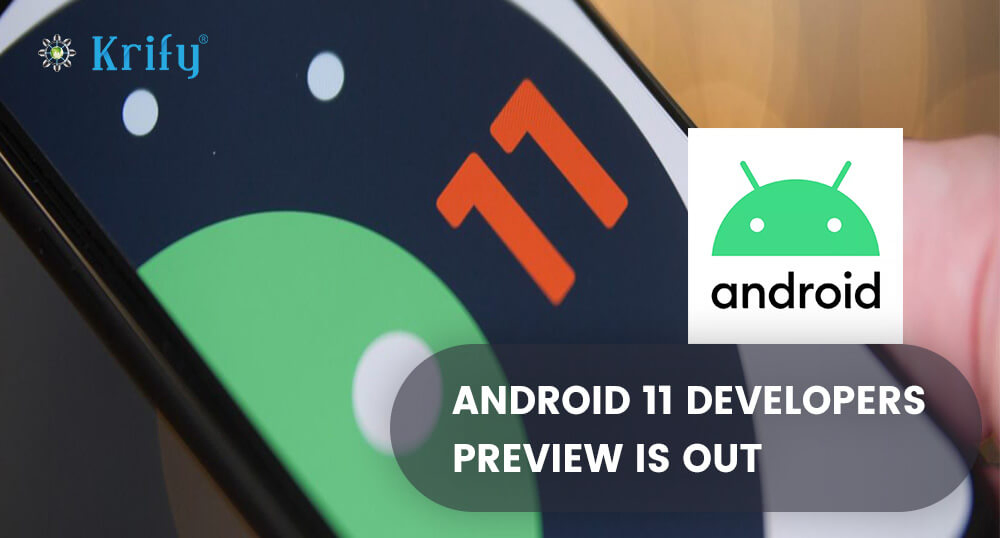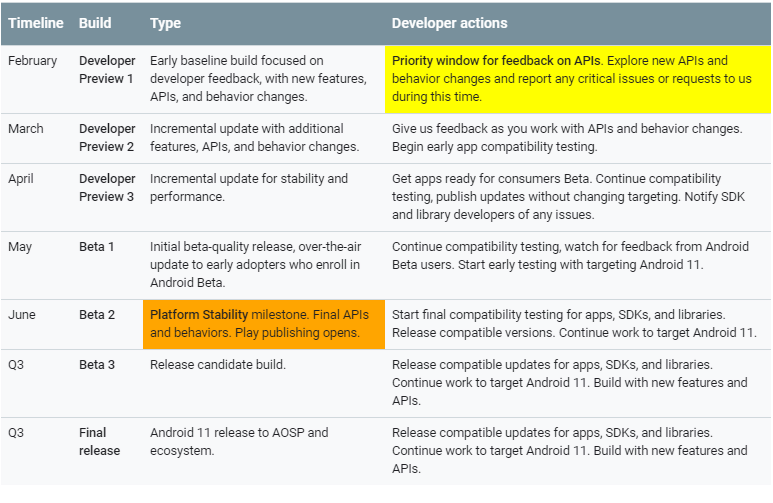Can February 2020, Google released its first Android 11 developers preview which is available for download now at developer.android.com. Google is preparing to deliver two more developers previews and three public betas before the stable release in Android 11. The company not yet decided the exact name for Android 11, but for now, it was named as Q3. This developer preview release is purely on fixing some early bugs and not adding or changing any user-facing features.
Google plans to release roughly one major update per month. For now, the company released Android 11.1 to address a few bugs that were present in the initial release. This preview includes SDK previews for developers with system images for the Pixel 2, Pixel 2 XL, Pixel 3, Pixel 3 XL, Pixel 3a, Pixel 3a XL, Pixel 4 and Pixel 4 XL and also official Android Emulator.
Timeline, milestones and updates
The Android 11 developers preview program runs from February 2020 until the final stable public release to AOSP and OEMs that are planned for Q3 2020. At every critical development, milestones, the company will deliver updates for your development and testing environments. Each development updates includes API references, SDK tools, Emulators, API diffs and System images. Here in the image below, there is a list of milestones:
Android 11 developer preview one features
Here is the list of new features and API that are introduced in Android Q3:
-
Insert images into notifications:
If your app supports image copy/paste, now you can allow users to insert images directly in the inline replies of notifications in the app itself. Image copy support is available in chrome while image paste support will show up in Gboard’s clipboard.
-
One-time permission:
Previously, users granted one-time permission for location access, but now they can provide temporary access to the device microphone and camera. This allows access until they exit the app. On next access to the app, they must request permission again.
-
Biometrics:
The biometrics feature in Android 11 has been expanded to meet the needs of a broader range of devices which supports three authenticator types with different levels of granularity such as Strong, weak and device credential. This prompt has been decoupled from the app’s activity lifecycle to make it simpler to integrate with various app architectures and to enhance the transaction UI.
-
Identity credentials:
Added platform support for secure storage and retrieval of verification identification documents such as ISO 18013-5 compliant mobile driving licenses.
-
Bandwidth estimator API:
Google has updated this API for 5G for making more accessible to check the downstream/upstream bandwidth without the support of poll the network or compute your own estimate. If the modem doesn’t give any assistance, the API will make a default estimation based on the current connection.
-
Pinhole and waterfall screens:
Apps can handle pinhole screens and waterfall screens by applying the existing display cutout APIs. If you want a new API that allows your app to use the entire waterfall screen, including the edges. With the help of insets to help you manage interactions near the edges.
-
Bubbles:
The Bubble API enables messages and chat apps to keep conversations in view, accessible while multitasking on devices.
-
Secure storage and sharing of data:
BlobstoreManager in the apps helps now to share data blobs quickly and more safely with other apps. The blob store ideal for use cases like sharing ML models among multiple apps for the same user.
-
Enhancement in calling screening service:
Call screening apps can now get the incoming call’s STIR/SHAKEN verification status as part of call details. Even they can customise system provided a post-call screen to let users perform actions such as marking a call as spam or registering to contacts.
-
Dynamic resource loader:
In Andoird 11 the resource loader framework loads resource and assets dynamically at runtime.
-
Bokeh modes:
Apps now in Android 11 uses metadata tags to allow bokeh modes on camera capture requests in supported devices. A still image mode will appear with highest quality capture whereas a continuous way assures that taking keeps up with sensor output such as for video capture.
Even more other features are provided in Android 11 developers preview are:
- Dynamic Meteredness API
- Dedicated conversations section in notification mode
- Neural Network API(NNAPI)1.3
- Scoped Storage
- Safer location access
- Platform hardening
- Secure storage and sharing of data
- Google Play System updates
- Minimizing the impact of behaviour changes
- Updated greylists
- New Platform stability milestone
- Easier testing and debugging
- WIFI suggestion API enhancements
- Passpoint enhancements
- Muting during camera capture
- HEIF animated drawables
- Low Latency video decoding in MediaCodec
- Native image decoder
- HDMI low-latency mode
Get Started
To get started, install Android 11 on your hardware devices or configure an emulator for compatibility testing.
Krify is the leading Android app development company in India and the UK having extensive experience in developing Android apps for various domains. For more please contact us today.






